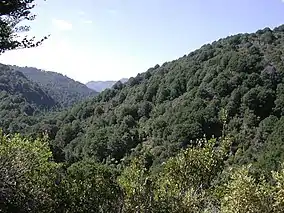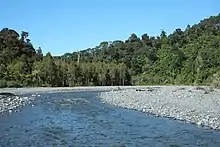Remutaka Forest Park
Remutaka Forest Park (spelled Rimutaka Forest Park prior to 2017) is a protected area near Wellington, New Zealand. Popular access points are south of Wainuiomata and in the upper Hutt Valley. The park covers 220 square kilometres (85 sq mi),[2] encompassing the Catchpool Valley and the Orongorongo Valley at the southern end of the Remutaka Range. Established in 1972, the park contains several short walks and six huts that can be booked and accessed by longer bush tramps. The park is one part of several local conservation areas, as it borders the Pakuratahi Forest and the Tararua Range.
| Remutaka Forest Park | |
|---|---|
IUCN category V (protected landscape/seascape)[1] | |
 Catchpool Valley | |
 Remutaka Forest Park | |
| Location | North Island, New Zealand |
| Nearest city | Lower Hutt |
| Coordinates | 41.36°S 175°E |
| Area | 22,000 hectares (54,000 acres) [2] |
| Established | 1972 |
| Governing body | Department of Conservation |
| Website | doc.govt.nz |
The park includes the Remutaka Rail Trail, dis-established rail line that operated from 1878-1955[3] that is now used for mountain biking and walking.
In 2017, the name of the park (and range) was changed from "Rimutaka" to "Remutaka" following a treaty settlement with Rangitāne o Wairarapa and Rangitāne o Tamaki nui-ā-Rua.[4] (The former name continues to be used in some online documents.)
Rare and protected species

The Orongorongo Valley is one of two known areas that host the endangered fungus boletopsis nothofagi.[5]
A population of North Island brown kiwi has been established in the northern part of the Remutaka Forest Park, called the Turere catchment kiwi zone.[6] To support the population's growth, kiwi eggs are transferred by volunteers to the Pukaha Mount Bruce Wildlife Centre and other protected areas such as the Wairakei Sanctuary for incubation and early growth.[7][8] The programme is working. In 2014, an analysis of acoustic recordings indicated that more than 100 birds were living in the park.[9] This is a 10-fold increase from the 10 kiwi that were originally released.[10]
The kiwi zone is protected by a dog exclusion area.[11] Dogs may run off lead within a defined exercise area in Catchpool Valley, but restrictions apply in the rest of the park.
Recreation
The park is a popular recreation area for the surrounding Wellington and Wairarapa regions. In the north, the Remutaka Rail Trail is used extensively by walkers and mountain bikers. The rail trail is generally accessed by road north of Upper Hutt, as the gradient to the summit is gentler on that side.[12] The Rimutaka Incline is on the eastern side of the summit and can also be accessed by road, south of Featherston at Cross Creek.
The back country hills attract hunting and multi-day hiking expeditions. The Orongorongo Valley is home to a number of private huts.[13]
At the Catchpool entrance, south of Lower Hutt, there are two camping areas as well as outdoor BBQs and flushing toilets.
Proposed de-extinction of moa
The park was the subject of a minor political argument surrounding a proposal to revive the extinct moa.[14] Local politician Trevor Mallard, called for support for a de-extinction attempt "50-100 years out".[15]
References
- Protected Planet. "Remutaka Forest Park".
- "Remutaka Forest Park". Department of Conservation.
The 22,000 ha Remutaka Forest Park encompasses much of the Remutaka Range. Easily accessible from Wellington, the area is popular with trampers and hunters.
- "Remutaka Rail Trail". Department of Conversation. Retrieved 14 January 2019.
- "Rangitāne o Wairarapa and Rangitāne o Tamaki nui-ā-Rua Deed of Settlement summary". New Zealand government. Retrieved 14 January 2019.
- Leonard, P.L.; McMullan-Fisher, S.; May, T.; Buchanan, P.; Cooper, J.A. (2016). Boletopsis nothofagi. The IUCN Red List of Threatened Species (Report). doi:10.2305/IUCN.UK.2016.RLTS.T80188388A95382635.en. ISSN 2307-8235.
- "Remutaka Forest Park: Catchpool valley and Oronorongo valley" (PDF). Retrieved 22 January 2019.
Dogs are not permitted at all in the Turere catchment kiwi zone
- "White kiwi's courtship ritual captured on film at Pukaha Mt Bruce". The New Zealand Herald.
Two other kiwi chicks are due to hatch shortly after arriving from the Rimutaka Forest Park Trust last week.
- "The Remu-talker" (PDF). December 2018. Archived from the original (PDF) on 21 December 2018.
Over the weekend of the 24th November our final three chicks returned to the Remutaka Forest Park. The birds have been at Wairakei International Golf course in Taupo.
- "Wellington Region Newsletter" (PDF). Ornithological Society of New Zealand—Birds New Zealand.
Susan Ellis, a volunteer with the Remutaka Forest Park Trust has recently been analysing acoustic recordings taken in 2014. A series of acoustic recorders were used in the park which contain an increasing population of brown kiwi, now believed to number greater than 100 birds.
- "Kiwi Project". Remutaka Forest Park Trust. Retrieved 22 January 2019.
The initial goal was to move a group (about 10 birds initially, in pairs) of North Island Brown kiwi from captivity in other locations nationwide to a 1000 hectare, predator-controlled site in the Rimutaka Forest Park to establish a viable, self-sustaining Kiwi population.
- "Dog access in Remutaka Forest Park". Department of Conservation. Retrieved 14 January 2019.
The Remutaka Forest Park Trust has released North Island brown kiwi into part of the Remutaka Forest Park. Kiwi have been released into the Turere Stream catchment north of the Orongorongo Track, an area of approximately 1000 hectares.
- "Parks Network Plan: Park-specific management and policies: Pakuratahi Forest" (PDF). Greater Wellington. July 2011. p. 77. Retrieved 22 January 2019.
The easy gradient of the Rimutaka Rail Trail (on the western side) is popular for walking and biking and continues into Cross Creek on the eastern side.
- Rebecca Jamieson; Allan Sheppard (18 December 2017). "The 50 private huts hidden in the Orongorongo Valley". thisNZlife. Retrieved 22 January 2019.
By 1970 there were already 60 huts in the valley, some dating back to the 1920s and 1930s.
- New Zealand government (18 July 2014). "Support for kiwi, not moas, in Rimutaka" (Press release). Scoop. Retrieved 22 January 2019.
“There is an irony in this Government grant for kiwi protection in the Rimutaka with Labour MP Trevor Mallard’s calls this month for recreating the moa in the same area.
- Simon Edwards; Vernon Small (10 July 2014). "Time to bring back... the moa". Stuff.
Asked about leader David Cunliffe's comment that "the moa is not a goer", Mallard said: 'The Moa will be a goer but we are talking 50 to 100 years out."
External links
- Rimutaka Forest Park Charitable Trust
- Department of Conservation (January 2019). Wellington Conservation Management Strategy 2019-2029. ISBN 978-1-98-851481-9.
| Wikimedia Commons has media related to Remutaka Forest Park. |